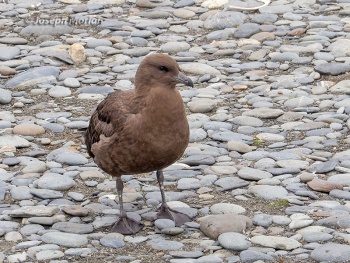Alternative names: Southern Skua, Subantarctic Skua, Antarctic Skua, Falkland Skua
- Stercorarius antarcticus
Identification

Photo © by Rodrigo Tapia
Ardley Peninsula, King George Island, South Shetland Archipelago, Antarctica, January 1992
Size: 52-64 cm (20½-25¼ in), wing 35.5-40.2 cm, wingspan 126-160 cm, females on average are larger in most measurements, most noticeably in wing length.
Nominate subspecies
- Brown overall plumage, variable from light to dark
- Pale streaking above
- Dark cap (often reduced to a mask in light morph birds)
Variations
Other races are larger, darker and less streaked above. Juveniles uniformly dark.
Distribution
Circumpolar Subantarctic islands, Antarctic Peninsula, Tristan da Cunha and Gough Islands; Falkland Islands and southern Argentina from Chubut to Tierra del Fuego.
Taxonomy
This species has been placed in the genus Catharacta with the other large skuas (Sibley & Monroe, 1993; Clements, 2000).
Older texts and some current field guides will treat Brown Skua as a part of Great Skua.
Subspecies
There are 3 subspecies[1]:
- S.a. antarcticus breeds in the Falkland Islands, and south-east South America: Smallest, most heavily streaked.
- S.a. hamiltoni breeds on Tristan da Cunha and Gough Island: Larger, darker, narrower streaks.
- S.a. lonnbergi breeds on the Antarctic Peninsula and Subantarctic Islands: Like S. a. hamiltoni but larger.
The subspecies lonnbergi has been treated as a full species Stercorarius lonnbergi by some authorities.[2]
Habitat
Pelagic. Inland (during breeding season)
Behaviour
Breeding
Oct-Nov onwards, on flat grassy areas or short grass heaths. Nest is an unlined or sparsely so, scrape. 1-2 eggs, incubated 28-32 days, young leave nest within 1-2 days and fledge in 40-50 days. Sexual maturity at six years.
Diet
Scavenger at refuse tips, predates penguin eggs and chicks and burrow nesting seabirds at night.
References
- Clements, J. F., T. S. Schulenberg, M. J. Iliff, D. Roberson, T. A. Fredericks, B. L. Sullivan, and C. L. Wood. 2017. The eBird/Clements checklist of birds of the world: v2017, with updates to August 2017. Downloaded from http://www.birds.cornell.edu/clementschecklist/download/
- Avibase
- BF member observations
- Handbook of the Birds of the World Alive (retrieved May 2018)
Recommended Citation
- BirdForum Opus contributors. (2025) Brown Skua. In: BirdForum, the forum for wild birds and birding. Retrieved 11 April 2025 from https://www.birdforum.net/opus/Brown_Skua
External Links
GSearch checked for 2020 platform.1






